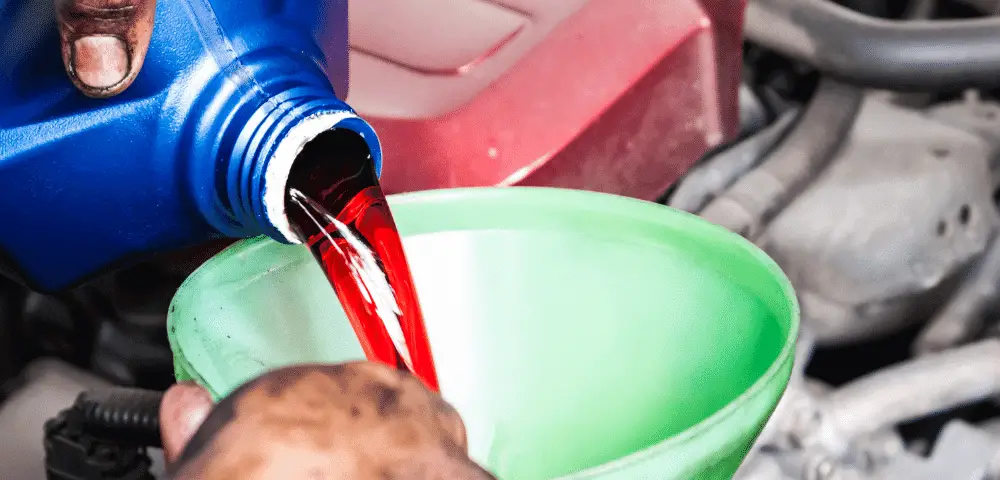There are a lot of different car fluids to keep track of for a car owner and each is integral to maintaining the performance of your car.
The transmission fluid is no different!
While it’s never recommended to do so, you can run your car slowly to the maximum of 10 miles in extreme emergencies.
Here’s everything you need to know about transmission fluid and what will happen if you drive without it.
What Is Transmission Fluid Purpose?
Most car owners usually neglect to keep up with the maintenance of their transmission fluid. They might forget to change it or they might not know when it’s running low.
But, before we begin, you might be wondering what exactly is the purpose of transmission fluid and what it does.
Basically, the transmission fluid acts as a lubricant for the bearings and the other components of the car.
It keeps them from grinding down as they move while you drive. This, in turn. protects the internal components of your car from wearing down as you drive and helps it deliver optimum performance.
The most important job of the transmission fluid is to make shifting the car easier by preventing friction as the gears turn. Moreover, depending on your car, it can even work as an alternative to the coolant.
The type of transmission fluid you use is based on the type of transmission your car has inside. You’ll mostly come across two types of transmission fluid: Automatic and manual.
Manual Transmission Fluid vs Automatic Transmission Fluid
You can tell the difference between the two types from transmission fluids from their name. Manual transmission fluid is used in cars with manual transmission and vice versa.
Manual transmission fluid is usually the cheaper one compared to its automatic counterpart.
That’s because there are far more moving pieces in a car with automatic transmission.
Moreover, automatic transmission fluids are also much thinner compared to manual fluids and are more optimized to reduce friction during a gear change.
They can also be used interchangeably in cars with manual transmission in most cases.
How Can You Run Out of Transmission Fluid?
In most cases, you won’t run out of transmission fluids for a long time.
However, there can be leaks in the transmission from where you can lose the fluid.
These leaks can develop over time due to several different reasons such as poor car maintenance, low-quality seal, or extreme heat around it.
Even if a small portion of the seal breaks, the level of transmission fluid in your car will eventually start decreasing until you run out of it entirely.
How can you tell if your transmission fluid is low?
So, how can you know that your car is running out of transmission fluid before you face the consequences of driving without it?
The answer is simple: just keep an eye out for any of the following symptoms.
1) Leaks
If there are any kind of fluid leaks in your car, the first symptom you’ll most likely see is marks or a pool of liquid on the ground. Be it coolant or transmission fluids, they will always pool on the ground if you keep your car idle.
2) Shifting gears difficulty
One of the first indications that your car is low on transmission fluids is difficulty in shifting gears. As the transmission fluid’s primary focus is to lubricate the internal gears in the car, the lack of it will eventually reflect as difficulty in shifting gears.
3) Overheating
If your car is running low on transmission fluids, you’ll also find the internal temperature of your car exceeding the optimal performance range.
You’ll either find a burning smell or if the problem persists, then smoke fumes coming out from the transmission block. This is a clear consequence of low lubrication and the resulting high friction between the gears.
4) Delayed shifts
Your car is designed to be highly responsive to your commands as you drive. This is especially true for the gear function, However, if the transmission fluid is low, you’ll encounter delayed response after you shift gears.
The slow response happens because the hydraulic becomes unable to generate the required power to shift gear at your command.
The two or three-second pause might not always be something that you’ll be able to identify immediately so keep a close look at the response time if you suspect low transmission fluid.
5) Inability to shift gears
This is the most glaring symptom of them all as well as the most serious one.
If you’re unable to shift gears, it means that the level of transmission fluids has become dangerously low. You need to immediately stop your car and get it towed to the nearest mechanic you can find.
It’s extremely dangerous to try and continue driving the car after reaching this point.
6) Unusual sounds
Another common symptom that you might face is a persistent grinding sound. If you drive on empty highways, this sound will be far more prominent to you.
The main culprit behind this sound comes from the high friction being generated in your gearbox due to low transmission fluids.
Moreover, your car will also indicate this problem through the engine light.
Can I drive my car if the transmission fluid is low?

The short answer is no.
You should never drive your car if the transmission fluid is low.
It can cause significant damage to your vehicle systems including the transmission, and the engine.
Furthermore, it’s a safety hazard as well as your car breaking down on the road can lead to a plethora of other problems for you.
In case of the most extreme emergencies, you can slowly drive your car for a few miles.
Some experts say that the limit is 10 miles. In that case, you should never go beyond the second gear or accelerate rashly. If you are driving an automatic, that becomes even more dangerous.
Even 10 miles would be pushing it when you are driving an automatic.
Driving a car without transmission fluids
So, what exactly happens if you drive a car without transmission fluids? To get to the gist of the matter, you’ll be leaving your transmission function extremely vulnerable to damage.
If you don’t solve this problem immediately, you can expect a complete breakdown of essential components in your car that will undoubtedly cost you hundreds of dollars to repair.
This isn’t even considering the damage that the increased friction could do to your car.
It’s better never to take a chance and drive your car if you suspect in any way that the level of transmission fluid in your car is low.
There’s no set deadline when the symptoms will appear and when the damage to your car’s internal system will occur.
Even if manage to identify even one of the mentioned symptoms, take immediate actions to stop the problem from escalating.
Will the engine even start if you run out of transmission fluid?
Unless there’s not even a drop of transmission fluid in your car, the engine will most likely not start.
The engine is heavily reliant on the transmission fluid to provide a connection to the gears. if the fluid is nonexistent, then the gears will simply never spin and your car will not be able to move.
How long can you drive without it?
It depends. As mentioned above, there’s no limit to how far you can drive without transmission fluids.
But this is only true for cars that come equipped with manual transmission.
Cars with automatic transmissions are designed to stop immediately after the transmission level hits a specific low level.
Final thoughts
The right amount of lubrication is essential for every part of your vehicle’s system.
The engine, brakes, transmission, and even the hydraulic system (if present) in your steering require the right amount of fluid for proper application.
The transmission fluid keeps the wear and tear of your transmission in check and plays an essential role in keeping it cool.
Without it, driving your car will result in catastrophic failure which would need time and money to repair.
In the direst of circumstances, you can break the rule and drive your car a bit, but you must be extremely careful, otherwise be prepared to spend a lot of money on repairs.


